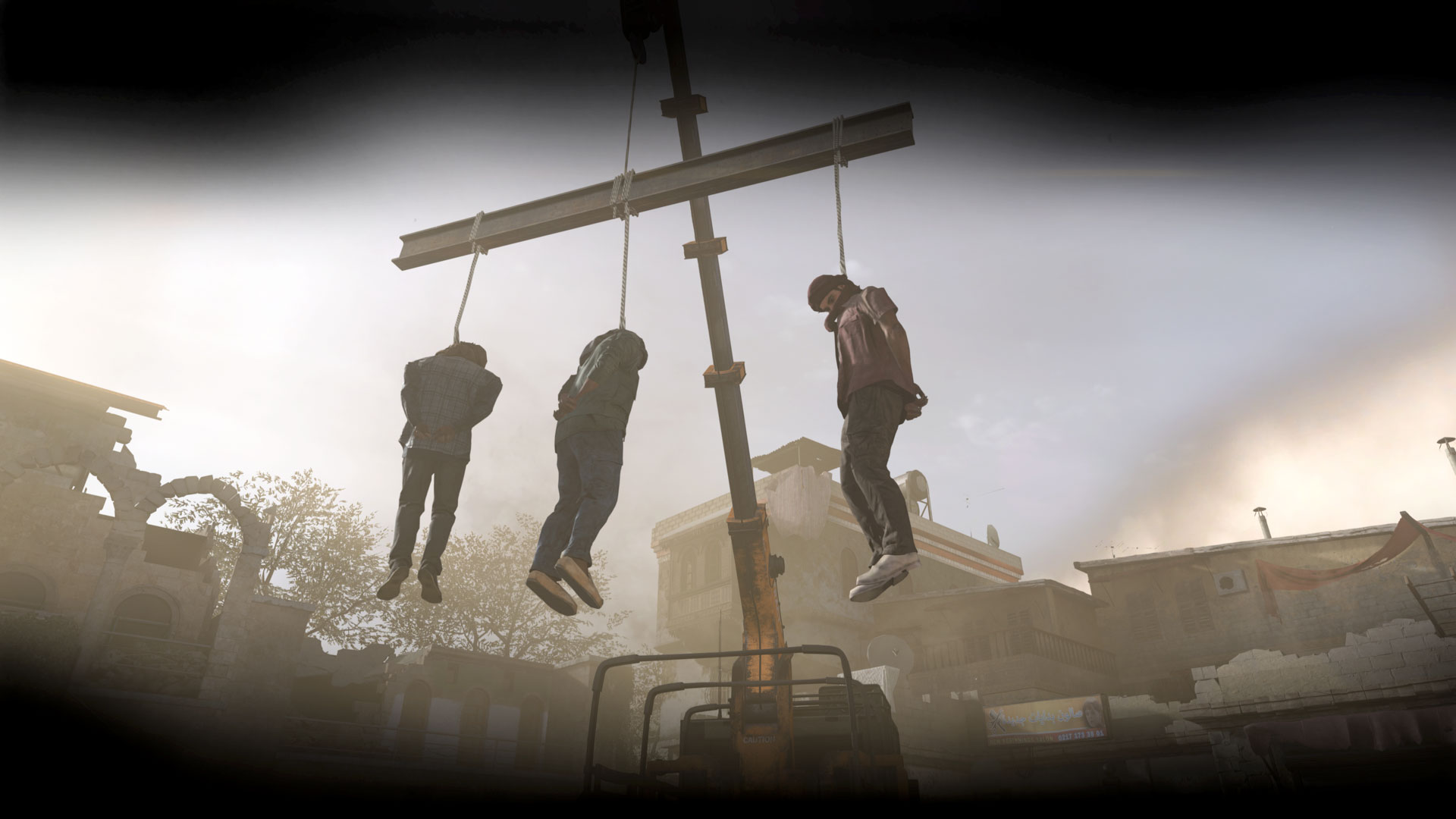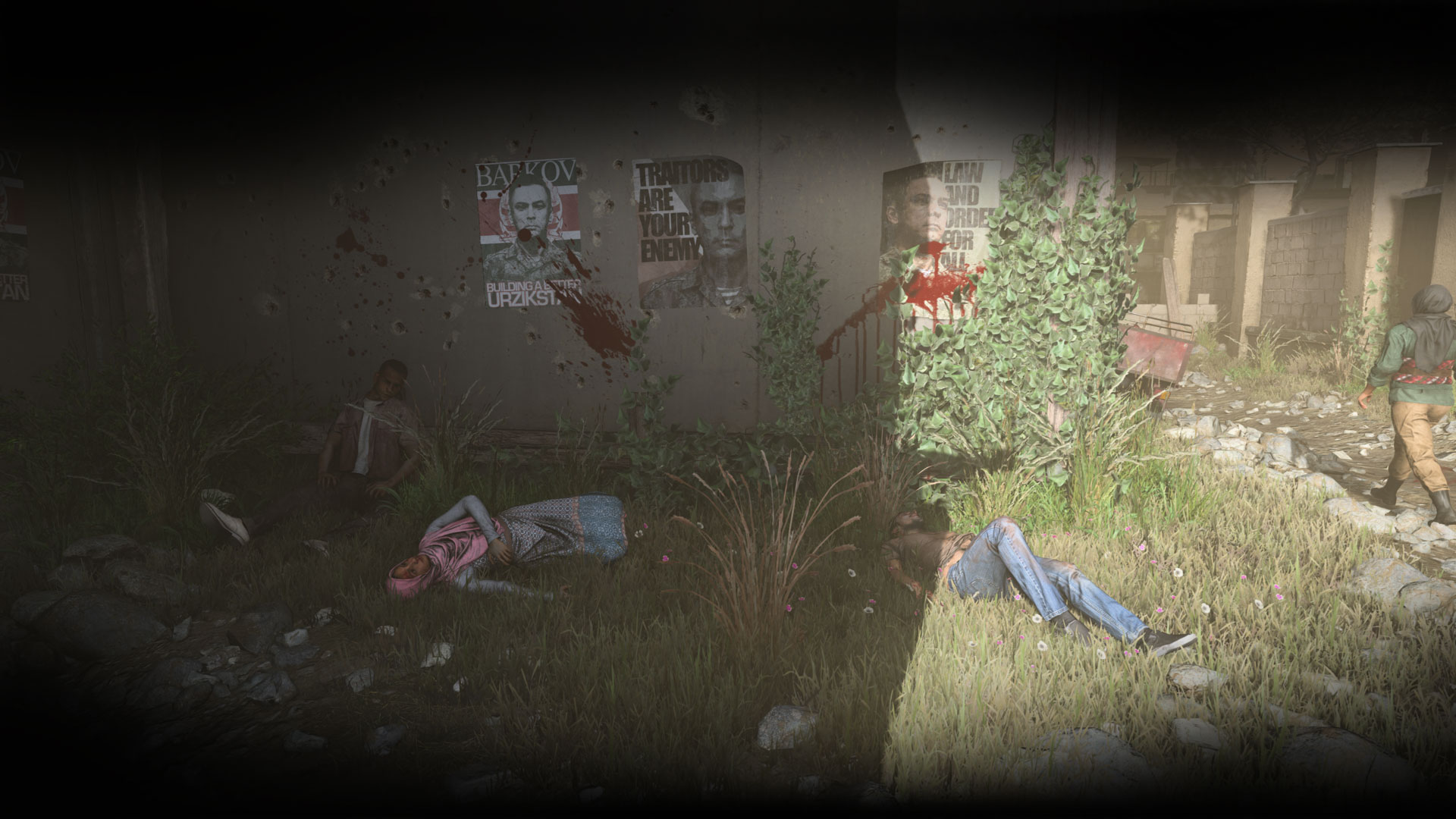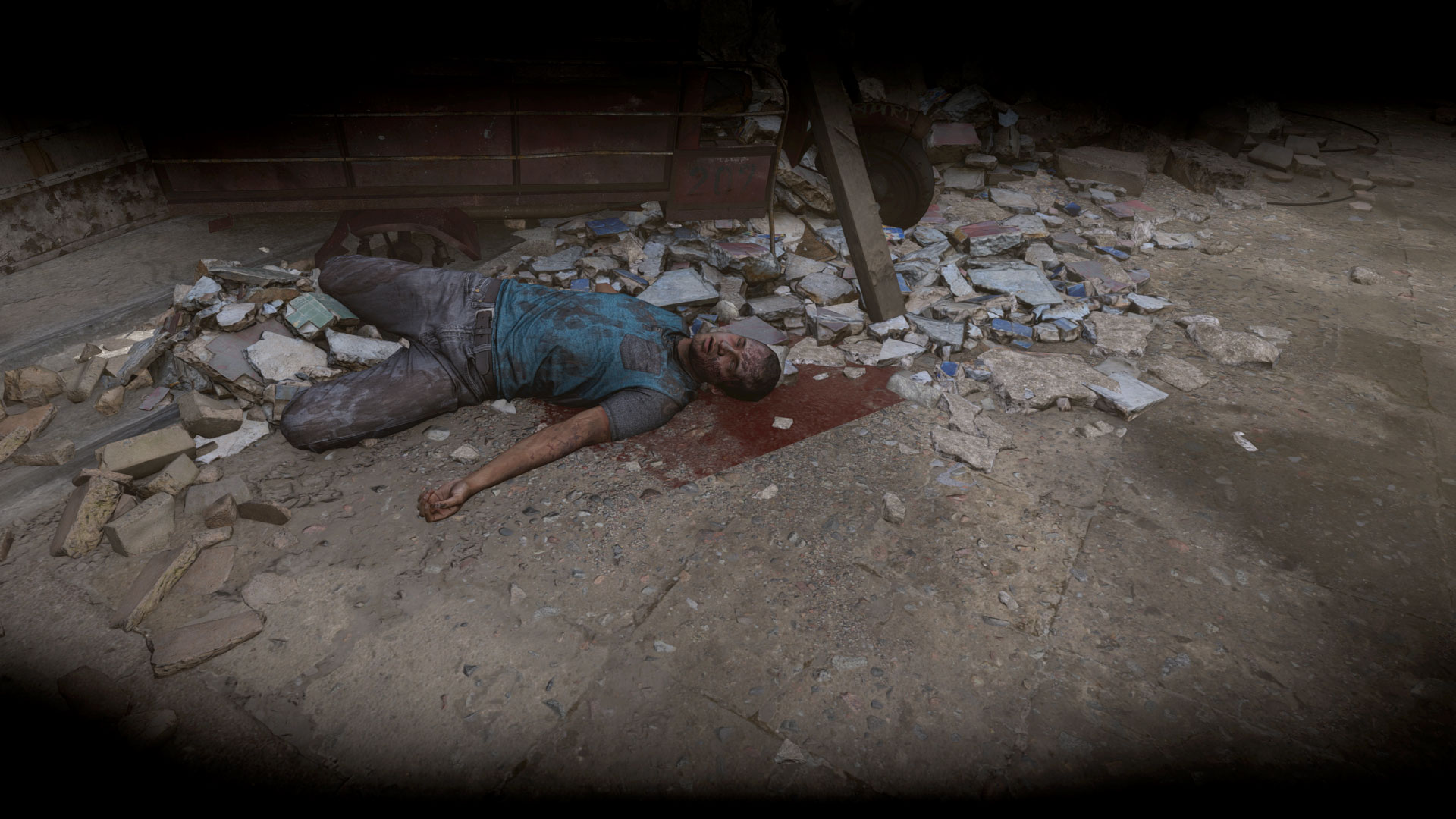Warning: This article contains graphic images captured from the Call of Duty: Modern Warfare campaign.
In most Call of Duty games, firefights play out across levels that resemble sanitized war museums. The player, cast as an Allied soldier in the Second World War or an American or British special operative in the postwar or modern era, sprints between smoldering, abandoned cars or bullet-pockmarked cement barriers to pop out, spray a round of bullets at the enemy, and take cover again to reload and let their health recharge. The battlefield is clearly delineated into two mutually antagonistic sides: There’s the player (and their often-invincible allies) and the opposition. Every unnamed character who runs across the screen is an enemy and must be shot.
Throughout Call of Duty: Modern Warfare, the confusingly named, recently released pseudo-remake of 2007’s Call of Duty 4: Modern Warfare, combat is more complicated. Set in 2019, it follows a CIA agent codenamed “Alex,” a militia leader called Farah, and SAS operatives Sergeant Kyle Garrick and Captain John Price as they scramble across the globe to thwart the plans of the fictional terrorist group Al-Qatala and Russian forces under the command of a maniacal general, Roman Barkov. The game centers around the Russian occupation of a fictional country called Urzikstan—a nation whose history and political situation freely, bewilderingly blends that of Syria, Iraq, and Afghanistan into a delirious vision of amorphous Western nightmares made whole.
Things are, unsurprisingly, very bad in Urzikstan. One of Modern Warfare’s first missions sees Alex under cover with a Kurdish-inspired militia fighting to overthrow its occupiers. A disguised Alex accompanies Farah, the militia’s commander, and watches with her as the absurdly villainous Russian forces oversee Urzikstani forced labor and scream at, beat, and summarily execute the local population. “This is a goddamn war crime,” Alex says, watching a row of civilians being hanged from construction equipment. Later in the mission, the player ends up in one of the series’ breathless action setpieces, storming an airbase to the sound of explosions and gunshots, but it’s the time spent watching the suffering of non-combatants that stands out.

It’s far from the only time this happens. Where past Call of Duty games have incorporated civilians into their levels only sporadically—the airport massacre of Modern Warfare 2’s “No Russian”; the fleeing Lagosians in Advanced Warfare’s highway shootout; the rescued child evacuated from a German warzone in Call of Duty: WWII—the new Modern Warfare is notable for its insistence on showing, with remarkable brutality, how war devastates ordinary people in just about every one of its levels. The game opens with a suicide bombing, which spirals into a mass shooting in packed London streets during which the player must spot armed enemies within crowds of panicked bystanders. Then there’s the long sequence depicting a chlorine gas attack on the fictional Urzikstan, a section that features two children picking their way through an apocalyptic cityscape filled with dead animals and kids, slaughtered White Helmet–reminiscent rescue workers, and piles of human corpses. Even in its tactical power fantasies, SAS Sergeant Garrick hunting through a multistory apartment building in a night raid, armed Al-Qatala members are mixed in with the group’s families. Mothers clutch their children as soldiers kick in doors, rifles leveled at their trembling, ghostly green, night-vision illuminated faces.
Surprisingly, for a series characterized (sometimes unfairly) for offering little but brain-dead action sequences, Modern Warfare wants its player to feel unsure of when—and if—to fire their weapons. This is commendable in a lot of ways. War, in most military shooters, is meant to look fun. The horror of the battlefield, even when the series takes place in lightly fictionalized versions of real cities, rarely seems to affect the people whose lives are destroyed by war. The latest Call of Duty, unlike other entries to the series, is designed from the ground up with the simple fact that most every warzone was (or still is) someone’s home firmly in mind. It’s an important corrective to more than a decade of modern military shooters, inspired by the 2007 Modern Warfare, that too often presented international combat as something like a deadly form of sightseeing—there were no civilians, only exotic backdrops.
As necessary an approach as this is, though, Modern Warfare’s seemingly never-ending series of horrifying scenarios—a child’s body, eyes staring lifelessly at the player in one moment, a bullet-ridden adult in street clothes slumped over the hood of a car in another—begin to force the question of what, exactly, the game wants to accomplish with its hours of hellish sights.

The Call of Duty games have always been something of a Rorschach test for those who play them. They are, as in the case of the original Modern Warfare and its sequel, indictments of the dead-end British and American wars in Iraq and Afghanistan while being simultaneously enamored with the aesthetic of 21st century war itself. One player might be willing to look past the chest-thumping surface level of these game’s hyperefficient Marines and special operatives to appreciate the cynicism of their horrorshow version of appalling real-world events; another, with just as much justification, may dismiss whatever message is trying to be conveyed because the medium of an action-packed war game starring Western soldiers (complete with multiplayer modes!) is too symbolically loaded to seem worthwhile.
This issue is even more pronounced in the new Modern Warfare, especially as its focus on war crimes mixes real-life references with the alternate reality of its fictional politics and geography. The game name-checks everything from the 2005 Haditha massacre, in which U.S. Marines killed 24 Iraqi civilians, to the Highway of Death, so named for the slaughter of retreating Iraqi forces and civilians on Highway 80 by an American-led coalition that included Canadian, British, and French forces during the 1990-91 Gulf War. The 2012 Benghazi attacks are recreated in a level that depicts the storming of an American embassy in Urzikstan, and the games invented factions are made up of stand-ins for ISIS and Al-Qaeda on one side and the Kurdish People’s Protection Units (or YPG) and Peshmerga on the other. With these confusing, slippery references in place, the way in which Modern Warfare chooses to interpret current events becomes even more immediately fraught than it’s been in the past.
Most disturbingly, the game reworks historical atrocities so that they’re the fault of its in-universe Russian military. The Haditha massacre is repurposed so that Modern Warfare’s Russian forces are shown murdering the civilians of a fictionalized, but still pointedly referenced, “Haditha, Urzikstan.” The Highway of Death is reconfigured for a level whose opening narration mentions that it was bombed by the Russian military during their invasion of Urzikstan, “killing the people trying to escape.” Neither of these events’ real-world counterparts, of course, involved Russia at all. Instead, Modern Warfare turns an uninvolved country—worse, one scapegoated for modern American political failings to avoid introspection—into a kind of sin-eater for American history, made cartoonishly villainous so as to absorb the United States’ abhorrent actions into its reputation.
It’s an irresponsible choice, but also one that’s puzzling considering that no country, real or invented, comes out of Modern Warfare looking good. The Americans, somewhat presciently, are shown deserting their pseudo-Kurdish allies in their moment of need, The British torture non-combatants and, with CIA support, carry out extrajudicial assassinations and sabotage. And Farah’s militia fights amongst itself after one member makes the decision to retaliate against the Russian occupiers with a gas attack of his own. The game obviously wants to suggest that no country is blameless in its version of a Syrian-inspired civil war, but its outsized, historically misleading depiction of one nation in particular—Russia—suggests that some international powers, none of them innocent, are just more guilty than others. There’s a sense here that the game wants to implicate the nation for its support of Syrian President Bashar al-Assad’s regime—the chemical gas at the center of the story is a pointed reference and serves as the “bridge too far” for Modern Warfare’s compromised Brits, Americans, and “good” Urzikstanis—but, in doing so, it redefines the line between what level of horror is acceptable when it comes to war crimes and what isn’t.

Beneath the game’s overwhelming cynicism, valuable in its way as a condemnation of war as a concept, there’s still a distinction between American, Britain, and their allies as bad and Russia and its allies as even worse. The only hope in this scenario, it suggests, is that individuals of conscience—lone soldiers within rotten armies, Russia included—will break ranks and do what needs to be done in order to bypass the evils officially authorized by their governments’ foreign policy. That this rugged individualism is essentially American libertarianism manifested in pessimistic military ideology doesn’t seem like an accident. In the end, Modern Warfare says, the kind of crimes committed by every country, spurred on by Russia’s plays for international influence, can only be countered by those willing to see through the miasma of politics and risk their lives to kill those responsible.
In this sense, the scenes of civilian horror are a cudgel used to remind players that they are participants in the world’s wars whether they belong to the military or not. Chillingly, Modern Warfare implies that all of us are at war, all of the time. Its confused morality hints that it is just, if not necessary, to ignore the boundaries of the law to stop whoever we deem responsible for the indiscriminate death caused around the world—terrorist or soldier, militia or regular military alike. We see Farah recover from a childhood destroyed by Russian occupation to do just that; we see valorous SAS soldiers ignore the Geneva Conventions to torture those who would inflict further suffering on other innocents. It’s never clear what gives these people the authority to flout the chain of command or the international order, nor whether any civilian would have the right to engage in similar acts of vigilantism.
Nowhere is this viewpoint clearer than in a scene near the end of Modern Warfare. In it, Alex is preparing to disobey orders and stay behind to get his hands dirty in an unsanctioned fight alongside Farah’s Urzikstani militia. A CIA station chief warns Alex that what he’s “doing is illegal.” Knowing that he must pick up his gun and do what has to be done regardless, Alex responds, “I’m pretty sure everything we do is illegal.” The horror will continue all around him, but, working on his own, the actions of one self-possessed soldier may spare local people from experiencing more of the brutality packed into the game’s previous hours.Alex, in the eyes of Call of Duty: Modern Warfare, is a real hero. If that comes across as an uncomfortable idea, it’s still not something that even a markedly conscientious entry to the series—one that on its surface is concerned with questioning the hazy morality of 21st century war—seems to consider a problem.
All images in this article are credited to Activision.

Reid McCarter is a writer and editor based in Toronto. His work has appeared at The AV Club, GQ, Kill Screen, Playboy, The Washington Post, Paste, and VICE. He co-wrote and co-edited the books SHOOTER and Okay, Hero, edits and contributes to Bullet Points Monthly, and tweets @reidmccarter.